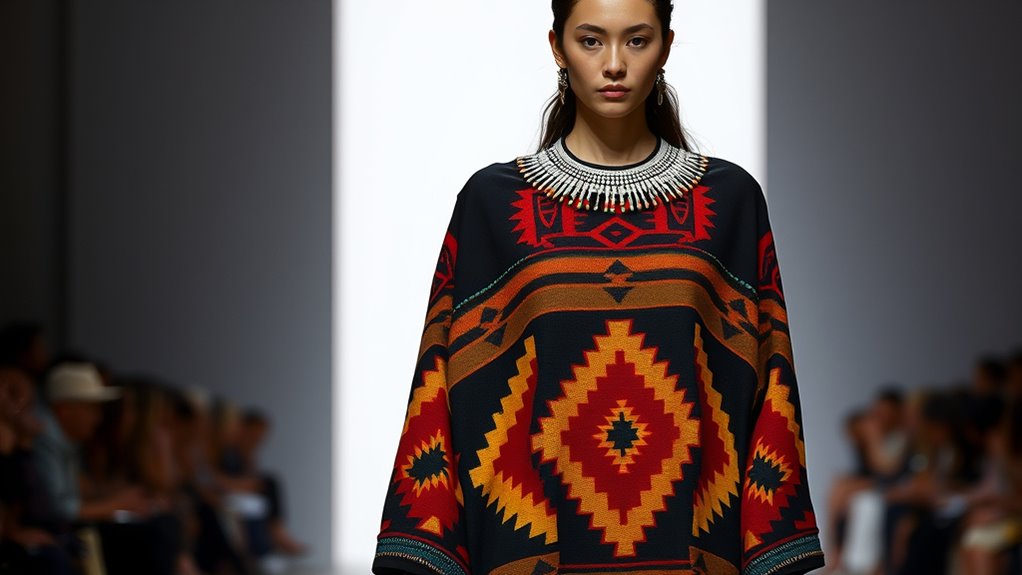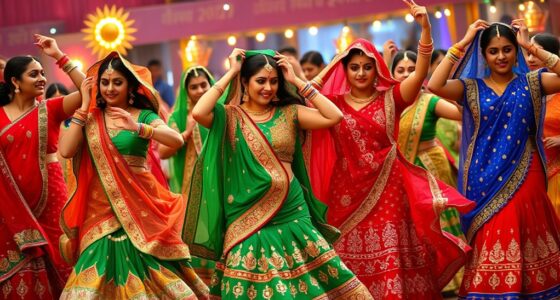Indigenous patterns influence modern fashion by adding cultural depth, storytelling, and tradition to contemporary designs. Designers often collaborate with indigenous communities to guarantee authenticity and respect, creating textile, print, and embroidery that honor cultural meanings. This fusion promotes diversity, visibility, and cultural dialogue, empowering indigenous groups while enriching fashion. If you continue exploring, you’ll discover how these patterns beautifully connect past and present, shaping a more inclusive and meaningful style landscape.
Key Takeaways
- Indigenous patterns serve as cultural symbols, storytelling elements, and visual signatures in contemporary fashion designs.
- Designers collaborate with indigenous communities to authentically incorporate traditional motifs into modern apparel.
- The integration of these patterns promotes cultural preservation and ethical support for indigenous craftsmanship.
- Respectful use of indigenous motifs fosters cultural appreciation, recognition, and prevents cultural appropriation.
- Incorporating indigenous patterns enhances diversity, representation, and cultural dialogue within the global fashion industry.

Indigenous patterns have become a vibrant and meaningful influence in modern fashion, blending traditional artistry with contemporary design. You might notice these patterns on runways, streetwear, or accessories, but their significance runs much deeper than aesthetics. They embody cultural identity, history, and storytelling, making their presence in fashion both a tribute and a dialogue between generations. When designers incorporate indigenous motifs, they often aim for more than visual appeal—they seek to preserve and honor the cultural significance behind each pattern. This intent guarantees that the patterns are not just decorative elements but serve as a bridge connecting past and present.
Indigenous patterns in fashion honor cultural storytelling, merging tradition with modern design as a meaningful tribute across generations.
Design integration is at the heart of how indigenous patterns influence modern fashion. You see this in the way designers adapt traditional motifs to fit current trends, creating a seamless fusion that respects origins while appealing to contemporary tastes. Instead of copying or superficial use, many brands collaborate directly with indigenous communities, ensuring authenticity and that cultural meanings are preserved. This respectful approach enhances the integrity of the patterns, allowing them to resonate authentically within new contexts. For example, traditional geometric shapes, symbolic colors, or storytelling motifs often find new life in textiles, prints, or embroidery, becoming distinctive signatures that elevate a piece’s cultural depth.
Integrating indigenous patterns also involves understanding the importance of cultural preservation and ensuring that traditional craftsmanship is valued and protected. Incorporating indigenous patterns also raises important conversations about cultural appreciation versus appropriation. When you encounter these designs, it’s essential to recognize their roots and the stories they carry. Authentic design integration involves more than just borrowing visual elements; it requires understanding the cultural significance behind them and giving proper credit or support to the communities of origin. Many brands now prioritize ethical collaborations, ensuring that indigenous artisans benefit economically and culturally from the use of their patterns. This approach not only fosters respectful appreciation but also helps sustain traditional craftsmanship, which might otherwise face decline.
Moreover, the use of indigenous patterns in fashion encourages a broader dialogue about diversity and representation. You’re witnessing a shift where traditional symbols are gaining visibility on global platforms, fostering recognition of indigenous cultures. This visibility can empower communities and inspire others to explore their own cultural narratives through fashion. Ultimately, the integration of indigenous patterns enriches modern fashion by adding layers of meaning and history, making each piece not just stylish but also a vessel of cultural storytelling and significance. As this influence continues to grow, it reminds us of the importance of respecting origins while celebrating the creativity that arises from cultural exchange.
Frequently Asked Questions
How Do Designers Ensure Cultural Accuracy When Adopting Indigenous Patterns?
You guarantee cultural accuracy by conducting thorough cultural consultations with indigenous communities, respecting their traditions and insights. You prioritize pattern authenticity by understanding the significance behind each design, avoiding stereotypes or misinterpretations. By collaborating directly with indigenous artists and respecting their ownership of patterns, you create respectful, authentic representations in your fashion. This approach not only honors their culture but also enriches your designs with genuine meaning and integrity.
Are There Legal Protections for Indigenous Designs in Fashion?
You should know that legal protections for indigenous designs are limited, but trademark laws can provide some safeguards. By registering patterns as trademarks, you can prevent unauthorized use. However, cultural sensitivity remains vital—respect indigenous communities’ rights and origins. Always seek permission and collaborate with indigenous designers to avoid cultural misappropriation. Combining legal protections with cultural awareness helps guarantee respectful and fair use of indigenous patterns in modern fashion.
How Do Indigenous Communities Benefit Financially From Fashion Collaborations?
When indigenous communities collaborate with fashion brands, they often benefit financially through licensing fees, royalties, or profit-sharing arrangements. This promotes economic empowerment by providing sustainable income and supporting community projects. Additionally, these collaborations help preserve cultural heritage, as communities maintain control over their designs and traditions. By valuing their creative contributions, you contribute to both their economic growth and the ongoing preservation of their cultural identity.
What Ethical Considerations Should Brands Follow With Indigenous Patterns?
You should prioritize respecting indigenous communities by avoiding cultural appropriation and always seeking community consent. Guarantee that your designs authentically represent their patterns and traditions, and collaborate with community members to maintain cultural integrity. Transparency about your intentions and fair compensation are essential. By doing so, you honor their heritage, foster trust, and create ethical fashion that benefits everyone involved.
How Can Consumers Identify Authentic Indigenous-Inspired Fashion Pieces?
To identify authentic indigenous-inspired fashion, look for signs of cultural authenticity, such as detailed craftsmanship and respectful use of patterns. Check if the brand emphasizes ethical sourcing and fair trade practices, supporting indigenous communities. Research the brand’s background to see if it collaborates directly with indigenous artists. Genuine pieces often come with transparent information about their origins, ensuring you’re supporting cultural integrity and ethical standards.
Conclusion
So, next time you wear that trendy shirt with indigenous patterns, remember—you’re actually carrying centuries of culture on your back. Ironically, what was once sacred or significant now often sits as a mere fashion statement. But hey, isn’t it fascinating how modern fashion can unintentionally keep indigenous traditions alive? Just don’t forget to respect the roots behind those patterns—after all, they’re more than just stylish designs; they’re stories.









